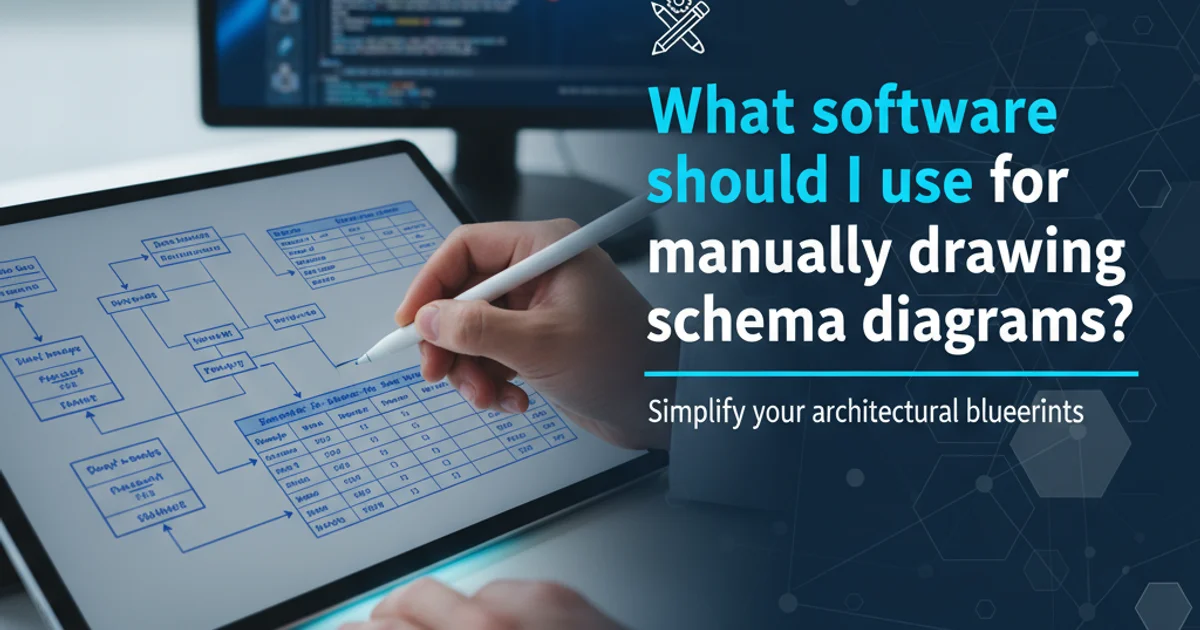What software should I use for manually drawing schema diagrams?
Choosing the Right Tool for Manual Schema Diagramming

Explore various software options for manually creating and visualizing database schema diagrams, from simple ERDs to complex system architectures.
Manually drawing schema diagrams is a crucial step in database design, helping to visualize relationships, identify potential issues, and communicate structure effectively. While many tools offer automated schema generation, sometimes a more hands-on approach is needed for conceptual design, documentation, or when working with existing, undocumented systems. This article explores popular software choices that empower you to create clear, comprehensive schema diagrams.
Understanding Your Diagramming Needs
Before diving into specific tools, it's important to assess your requirements. Are you creating a simple Entity-Relationship Diagram (ERD) for a small project, or do you need to model a complex enterprise system with hundreds of tables? Do you require collaboration features, version control, or the ability to export to various formats? Your answers will guide you toward the most suitable software.
flowchart TD
A[Start: Need to draw a schema?] --> B{Complexity?}
B -->|Low (Few tables)| C[Simple Drawing Tool]
B -->|High (Many tables, relations)| D[Dedicated ERD Tool]
C --> E{Collaboration Needed?}
D --> E
E -->|Yes| F[Online Collaborative Tool]
E -->|No| G[Offline Desktop Tool]
F --> H[Choose Tool]
G --> H
H --> I[End: Diagram Created]Decision flow for choosing a schema diagramming tool.
Popular Tools for Manual Schema Diagramming
Several categories of tools can assist with manual schema diagramming, each with its strengths and weaknesses. We'll look at general-purpose diagramming tools, dedicated ERD tools, and code-based solutions.
General-Purpose Diagramming Tools
These tools are versatile and can be used for various types of diagrams, including ERDs. They offer a wide range of shapes, connectors, and customization options.
- Lucidchart / draw.io (diagrams.net): Web-based, highly collaborative, and feature-rich. Excellent for team projects and offers a vast library of shapes, including ERD symbols. draw.io is free and open-source.
- Microsoft Visio: A powerful desktop application with extensive templates and stencils for professional diagrams. Best for Windows users who need advanced features and integration with other Microsoft products.
- OmniGraffle (macOS): A Mac-native application known for its intuitive interface and powerful diagramming capabilities, often preferred by designers and developers in the Apple ecosystem.
Dedicated ERD Tools
These tools are specifically designed for database modeling and often include features like forward/reverse engineering, SQL generation, and database-specific notations.
- MySQL Workbench: While primarily a visual tool for database administration, it includes robust ER modeling capabilities. It's free and open-source, making it a popular choice for MySQL users.
- dbForge Studio for MySQL/SQL Server/PostgreSQL: A comprehensive IDE that includes powerful database design and ERD tools. Offers advanced features for professional database developers.
- ER/Studio (Embarcadero): An enterprise-grade data modeling tool that supports a wide range of databases and offers advanced features for large-scale data architecture.
Code-Based Diagramming
For those who prefer a text-based approach or want to integrate diagramming into their development workflow, tools that generate diagrams from code or markup are excellent.
- Mermaid: A JavaScript-based diagramming tool that renders diagrams from markdown-like text. It's excellent for embedding diagrams in documentation and version control.
- PlantUML: Similar to Mermaid, PlantUML allows you to define diagrams using a simple text language. It supports various diagram types, including ERDs, and can be integrated into many IDEs and documentation generators.
Example: Creating a Simple ERD with Mermaid
Mermaid offers a lightweight yet powerful way to define ERDs using plain text. This is particularly useful for documentation within code repositories or markdown files. Below is an example of a simple ERD for a blog application.
erDiagram
USER ||--o{ POST : has
POST ||--o{ COMMENT : has
USER {
VARCHAR(255) id PK
VARCHAR(255) username
VARCHAR(255) email
}
POST {
VARCHAR(255) id PK
VARCHAR(255) title
TEXT content
DATETIME created_at
VARCHAR(255) user_id FK
}
COMMENT {
VARCHAR(255) id PK
TEXT content
DATETIME created_at
VARCHAR(255) post_id FK
VARCHAR(255) user_id FK
}A simple Entity-Relationship Diagram (ERD) for a blog using Mermaid syntax.
This Mermaid code defines three entities: USER, POST, and COMMENT, along with their attributes and primary/foreign key relationships. The ||--o{ notation indicates a one-to-many relationship (one user has many posts, one post has many comments).